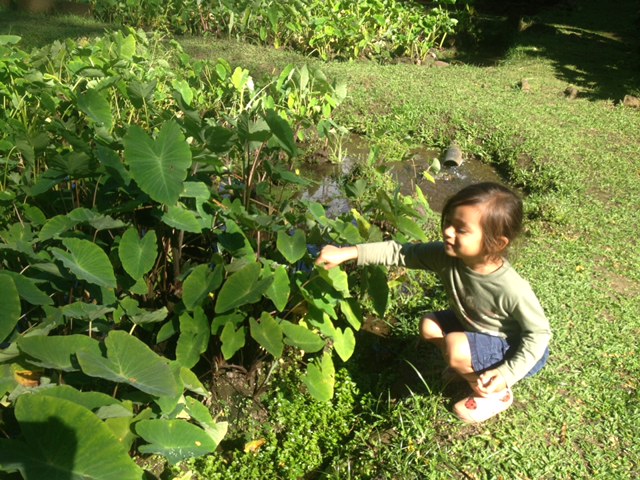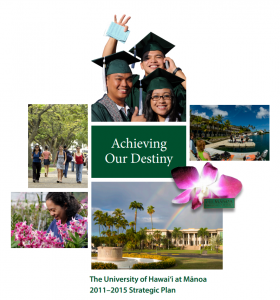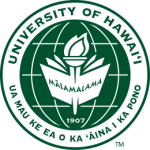What is a Native Hawaiian Place of Learning?

A Native Hawaiian place of learning is responsive to the needs and assets of Native Hawaiian communities and is reflective of Indigenous Hawaiʻi.
Since 1986, there have been four reports written that guide UH Mānoa in becoming a Native Hawaiian place of learning.
What does ‘Native Hawaiian place of learning’ really mean?
Since the 2002 strategic plan, UH Mānoa has aspired to be a Hawaiian Place of Learning. When our office was established in 2017 we began to ask our campus:
- What does a “Hawaiian Place of Learning” really mean?
- What is the essence?
We listened to our on-campus and off-campus communities and what we heard repeatedly is that at the heart of every Native Hawaiian place of learning is aloha ‘āina.
What is Aloha ʻĀina?
There are many ways to define aloha ‘āina and we recognize that it can take a lifetime to fully understand the deeply rooted value and practice that is unique to Hawai‘i yet profoundly connected to many cultures around the world. We also recognize that there are imperfections in trying to describe and translate between Hawaiian language and English as well as the worldviews that they hold.
All our hesitations aside and guided by the Kūali‘i Council, we describe aloha ‘āina as a recognition, commitment, and practice sustaining the ea – or life breath – between people and our natural environments that resulted in nearly 100 generations of sustainable care for Hawai‘i. We recognize that it is because of the aloha ‘āina practiced by Native Hawaiians over many centuries that we can enjoy the Hawai‘i we have today.
We ask ourselves: How will we pay it forward?
Aloha
The relationships and consistent reciprocal care between all parts of our world to sustain pono and well-being.
– Kūali‘i Council, 2018
ʻĀina
Our environments – the land, sea, and skies – as well as the people and the knowledge systems that are deeply rooted in sustainable care and pono for Hawai‘i.
– Kūali‘i Council, 2018
A Genealogy of 'Native Hawaiian Place of Learning' and 'Aloha ʻĀina' at UH Mānoa
He mo‘okū‘auhau
A Genealogy
Below is a genealogy of how ‘Native Hawaiian place of learning’ and ‘aloha ‘āina’ have been incorporated into UH Mānoa guiding documents over the last three decades. Each document shapes the succeeding documents, thus they are connected and form a genealogy. We thank the many people who have worked tirelessly on the creation and implementation of the goals and recommendations from these documents.
The Kaʻū Report was the first time the UH system investigated why there were so few Native Hawaiians in the UH System and provided recommendations in six areas:
- Hawaiian Studies Center
- Curriculum and Instruction
- Hawaiian Studies Research
- Hawaiian Student Recruitment and Retention
- Faculty Development and Leadership
- Service to the Hawaiian Community

The UH Mānoa strategic plan is the first time that the phrase "Hawaiian place of learning" arises in the discussions of working groups quoted in the document, including the concept that Mānoa can be a “globally-connected Hawaiian place of learning.” One of the strategic imperatives of this plan states, “Recognize our kuleana to honor the indigenous people and promote social justice for Native Hawaiians.”

The phrase "Hawaiian place of learning" lives on in the strategic plan. One of the values states, “Hawaiian place of learning: The significance of Mānoa as a campus physically and conceptually grounded in Native Hawaiian knowledge and values cuts across each of our strategic goals. Hawai‘i’s unique location and strength in indigenous scholarship sets us apart from other universities.” Further, within the strategic goals, particularly Goal 1: A Transformative Teaching and Learning Environment, the goal is set to “Promote a Hawaiian Place of Learning.” While the term 'Hawaiian' is used rather than 'Native Hawaiian' to describe the place of learning, it is clear that the term is referring to Native Hawaiians, the indigenous people of Hawai‘i.
“The Commission recommends that the University continue to articulate the measurable attributes of a Hawaiian Place of Learning and promote this as a core distinction of education at UHM.”
The Hawaiʻi Papa o Ke Ao Report is a follow-up to the 1986 Ka‘ū Report. Recommendations are made in the following areas:
- Leadership Development
- Community Engagement
- Hawaiian Language and Cultural Parity
While the UH System worked on their follow-up to the 1986 Ka‘ū Report, UH Mānoa engaged in its own process to create the Ke Au Hou report. Recommendations were made in the following areas:
- Native Hawaiian Student Success
- Native Hawaiian Staff/Faculty Development (and NH development for ALL staff and faculty)
- Native Hawaiian Environment
- Native Hawaiian Community Engagement

This letter recognizes progress and also notes room for further improvement. “The university has made progress in implementing the 2012 task force recommendations supporting UHM as a Hawaiian place of learning. The proportion of Native Hawaiian students and the number of degrees granted are increasing, although graduation rates lag other groups. Native Hawaiian faculty are also increasing and expanding to new departments, but represent 6% of the faculty.”
The Ka Hoʻokō report is a follow-up to the 2012 Ke Au Hou report and provides additional strategies for both short-term and long-term outcomes in the four focus areas.
This position is responsible for the strategic implementation of the recommendations from all the Native Hawaiian reports. Beginning with the 1986 Ka‘ū Report there has been a recommendation to create a Vice Chancellor and/or Vice President of Native Hawaiian Affairs. While this is not a VC/VP position, this is the first Native Hawaiian Affairs executive position of its kind at UHM.
When the Native Hawaiian Affairs Program Officer was hired, one of the first things she did was engage different stakeholders in the question “What does a Hawaiian place of learning mean to you?” The Native Hawaiian advisory body to the chancellor, Kūali‘i Council, honed their focus on aloha ‘āina as the core and essence of a Native Hawaiian place of learning. They produced a document that articulated that essence and guides the work of the Native Hawaiian Affairs Program Officer.
When the UHM WASC committee was tasked to identify a thematic area that represents UHM’s strengths and an area we want to continue to strengthen, after many meetings and considerations, aloha ‘āina was decided upon by the group as an important theme to include.

Similar to the WASC conversation, as we thought about all that is being reflected from our community, in climate change conversations, and the direction of our Native Hawaiian place of learning work, aloha ‘āina was determined to be a necessary guiding kuleana for the university in its newest strategic plan.
